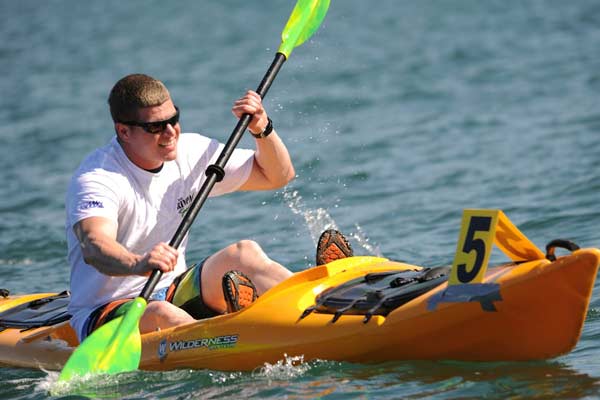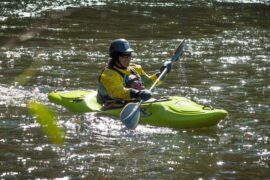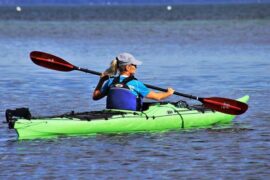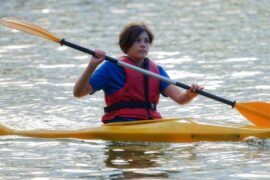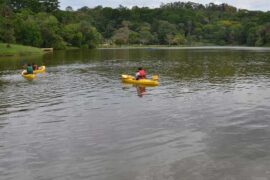Kayaking is good for the soul. It helps with weight management, improves upper-body stretch, and improves cardiac health.
Furthermore, kayaking ensures that you have a good time. However, if you are going kayaking for the first time, you could have this question in mind, “do kayaks flip over easily?”
The most logical answer is no; kayaks do not flip over easily. Kayaks built for new kayakers are created with stability in mind, and they rarely capsize. However, a kayak can still capsize, especially if you paddle during windy conditions.
This article discusses more kayaks flipping over and preventing that from happening. With the tips we will provide, you can confidently go on your first kayak adventure. But before that;
What Cause Kayaks to Flip Over?
Kayaks can flip over because of the following reasons:
Loss of balance
For most new kayakers, the primary reason for kayaks flipping over is the loss of balance. Generally, new kayakers are still not comfortable in the water. Also, the new adventurer could have so much fun that they forget to keep their balance.
Every kayak is designed to provide an outstanding amount of secondary and primary stability. The kayak’s primary stability gives it steadiness on flat water, and the secondary stability helps it stay stable when leaning over.
Kayaks that are primarily made for beginners have excellent primary stability. This makes them the best bet when paddling on flat water, and they often feel stable.
However, even if they have top-notch primary stability, the kayak will probably throw you in the water if it gets tipped over from the side by waves, wind, or paddler error.
Sea kayaks come with top-notch secondary stability, but their primary strength is wanting. Therefore, if you use a sea kayak, you must know how to use a boat that can feel tippy sometimes.
Many people who capsize with a sea kayak in calm water feel like losing their balance. For that reason, they try to tip over to the other side, which makes their weight shift in an odd direction, making the kayak flip over.
As you get more experienced kayaking, the likelihood of capsizing with a kayak decreases. Yes, capsizing can be frustrating, especially in calm water, but you will improve as you keep practicing.
Winds and waves
Wind and waves can also make a kayak flip over if you are not well prepared for the conditions.
The windy weather makes it difficult for even experienced kayakers to stay comfortable in their kayaks, regardless of the design of the kayak they are using.
Sea kayaks are often better in windy conditions, thanks to their excellent secondary stability. Also, experienced paddlers will probably not capsize because of bad weather.
Therefore, if you are still new to kayaking or don’t trust your kayaking abilities, you should avoid kayaking in windy weather.
As you get more experienced, you can start testing your boundaries by trying in more challenging conditions. But if you are starting, first know how to do it on flat water, and then you can try it out in rough weather.
How to Prevent A Kayak from Capsizing
No one wants to flip over with their kayaks. So, if you can prevent it, you do it. Here are a few tips to help you out:
Choose the ideal paddling conditions
The most obvious way to prevent your kayak from tipping over is by picking the best conditions to paddle.
As aforementioned, foul weather (wind and waves ) increases the risk of flipping over with your kayak. Therefore, choose the right temperature for paddling.
Choosing the ideal paddling weather requires understanding your kayaking abilities and limitations.
For example, suppose you are a beginner using a recreational kayak with insufficient secondary stability. In such a scenario, you are likely to flip over compared to an experienced kayaker using a sea kayak.
If you doubt your kayaking abilities and the weather is not very friendly, it is best to forego kayaking that day than put your life in danger kayaking in water that you can’t handle yet.
Distribute your weight and equipment evenly.
While it takes time and practice to master balancing a kayak, you can make it easy for you by distributing the weight of your gear appropriately.
If the gear on your kayak is not uniformly distributed, you will likely capsize when you lose balance momentarily. This is especially true in stormy conditions but can still occur in calm water.
The idea is to distribute your equipment’s weight over your kayak appropriately. Avoid loading excessive weight into the stern hatches of the kayak. Attempt to pack equal amounts of equipment on the port and starboard sides of the kayak.
The idea is to create an evenly balanced kayak before entering the water to prevent making paddling more difficult.
Use the low brace
This kayaking technique can swiftly right your boat if you feel it’s going to topple. When you feel like you lean to one side in the kayak, use your core to push yourself back up to a vertical position.
The idea is to catch yourself mid-fall with the paddle’s blade. Experience with the low brace on calm water is essential before trying it out in more challenging conditions.
Use the high brace
Starting with your hands in the pull-up position, bring the paddle in front of your body to around chest level. It would help if you plunged the blade’s practical side into the water.
In comparison to the Low Brace, this stroke has more power. That gives you more time to shift your weight back under the paddle blade and recover your equilibrium.
However, the High Brace has the drawback of increasing the strain on your shoulders. You should carefully consider the frequency and intensity of your High Brace usage and the stresses you place on your shoulders.
What to Do if You Capsize With Your Kayak
Despite the best efforts, your kayak could still flip over. If that happens, call a friend to help you rescue the kayak. But first, run and swim to the boat for safety.
